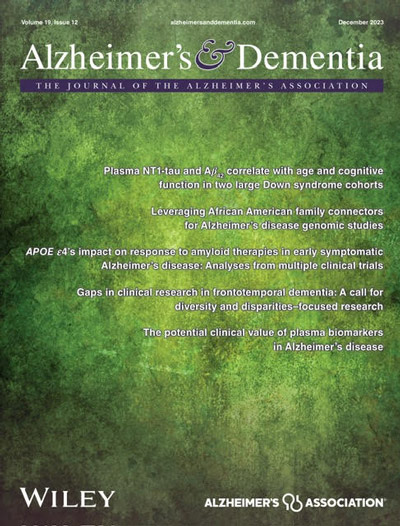荧光[18F]氟陶西哌类似物(T726)的显微镜评估显示神经病理学与3R和4R tau病变重叠
IF 13
1区 医学
Q1 CLINICAL NEUROLOGY
引用次数: 0
摘要
[18F]氟曲霉素(FTP)与阿尔茨海默病(AD)中成对螺旋丝(PHF)tau的结合已被广泛接受。在额颞叶变性(FTLD)中,与3R和4R tau的结合还存在争议。我们旨在研究一种FTP荧光类似物(T726)是否有助于揭示这一争议。本文章由计算机程序翻译,如有差异,请以英文原文为准。
![Microscopy assessment of a fluorescence [18F] flortaucipir analog (T726) shows neuropathological overlap with 3R and 4R tau lesions](https://img.booksci.cn/booksciimg/2024-10/2024102410172302353594.png)
Microscopy assessment of a fluorescence [18F] flortaucipir analog (T726) shows neuropathological overlap with 3R and 4R tau lesions
[18F] flortaucipir (FTP) binding to paired helical filament (PHF) tau in Alzheimer's disease (AD) is well accepted. Binding to 3R and 4R tau in frontotemporal lobar degeneration (FTLD) is controversial. We aimed to investigate whether an FTP fluorescent analog (T726) can help shed light on this controversy.
求助全文
通过发布文献求助,成功后即可免费获取论文全文。
去求助
来源期刊

Alzheimer's & Dementia
医学-临床神经学
CiteScore
14.50
自引率
5.00%
发文量
299
审稿时长
3 months
期刊介绍:
Alzheimer's & Dementia is a peer-reviewed journal that aims to bridge knowledge gaps in dementia research by covering the entire spectrum, from basic science to clinical trials to social and behavioral investigations. It provides a platform for rapid communication of new findings and ideas, optimal translation of research into practical applications, increasing knowledge across diverse disciplines for early detection, diagnosis, and intervention, and identifying promising new research directions. In July 2008, Alzheimer's & Dementia was accepted for indexing by MEDLINE, recognizing its scientific merit and contribution to Alzheimer's research.
 求助内容:
求助内容: 应助结果提醒方式:
应助结果提醒方式:


